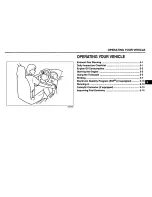
If you are not wearing a
seat belt in a crash, you could be
thrown forward into the
dashboard and crush the child.
During a
crash, the belt could press deep
into the child and cause very
serious injuries.
According to accident statistics,
children of all ages and sizes are
safer when they are restrained in the
back seat, not the front seat. The
National Highway Traffic Safety
Administration and Transport
Canada recommend that all children
ages 12 and under be properly
restrained in the back seat.
In the back seat, children are less
likely to be injured by striking hard
interior parts during a collision or
hard braking. Also, children cannot
be injured by an inflating airbag
when they ride in the back.
Front airbags have been designed to
help protect adults in a moderate to
severe frontal collision. To do this,
the passenger’s front airbag is quite
large, and it inflates with tremendous
speed.
If you are wearing a seat belt, the
child can be torn from your arms
during a crash. For example, if
your car crashes into a parked car
at 30 mph (48 km/h), a 20-lb
(9 kg) infant will become a 600-lb
(275 kg) force, and you will not be
able to hold on.
If the airbag
inflates, it can hit the back of the
child seat with enough force to kill or
very seriously injure an infant.
Driver and Passenger Saf ety
Protecting Children
Additional Precautions to Parents
Never hold an inf ant or child on
your lap.
Never put a seat belt over yourself
and an inf ant or child.
Inf ants
Never put a rear-f acing child seat in
the f ront seat of a car equipped with
a passenger’s airbag.
Children Should Sit in the Back
Seat
The Passenger’s Front Airbag
Poses Serious Risks to Children
22
















































